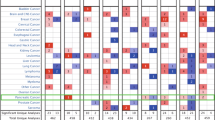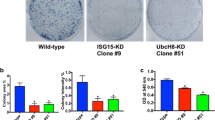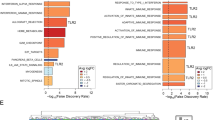Abstract
Purpose
Interferon-induced protein with tetratricopeptide repeats 3 (IFIT3) gene from IFITs family is one gene among hundreds of IFN-stimulated genes. The potential role of IFIT3 in cancer is scarcely understood. In addition, the clinical relevance of IFIT3 is not yet known in pancreatic ductal adenocarcinoma (PDAC). We evaluated the prognostic significance of this gene in PDAC patients.
Methods
The expression of IFIT3 was analyzed in pancreatic cancer cell lines with different metastatic potential (FG and L3.6pl) and one established gemcitabine resistant cell variant-L3.6plGres. Second, we analyzed the protein expression in tissue microarrays (TMA) from specimens of 254 radically resected patients with pancreatic adenocarcinoma. The prognostic relevance of IFIT3 was evaluated by the Kaplan–Meier and Cox regression analysis.
Results
L3.6pl cells with an aggressive capacity showed a significant higher expression of IFIT3 as compared to FG cells. IFIT3 was accumulated in gemcitabine resistant cells. Overexpression of IFIT3 increased the resistance of apoptosis against gemcitabine treatment. Patients who had high expression of IFIT3 (32%) and received chemotherapy had a statistically significant reduced survival in multivariate analysis.
Conclusions
High expression of IFIT3 enhances anti-apoptotic activity and chemotherapy resistance of PDAC cells. High expression of IFIT3 was independently correlated to shorter patients’ survival and may serve as a prognostic marker.





Similar content being viewed by others
References
Carmichael J (1998) The role of gemcitabine in the treatment of other tumours. Br J Cancer 78(Suppl 3):21–25
Chiorean EG, Coveler AL (2015) Pancreatic cancer: optimizing treatment options, new, and emerging targeted therapies. Drug Des Dev Ther 9:3529–3545. doi:10.2147/DDDT.S60328
Distler M, Ruckert F, Hunger M, Kersting S, Pilarsky C, Saeger HD, Grutzmann R (2013) Evaluation of survival in patients after pancreatic head resection for ductal adenocarcinoma. BMC Surg 13:12. doi:10.1186/1471-2482-13-12
Dusch N, Weiss C, Strobel P, Kienle P, Post S, Niedergethmann M (2014) Factors predicting long-term survival following pancreatic resection for ductal adenocarcinoma of the pancreas: 40 years of experience. J Gastrointest Surg Off J Soc Surg Aliment Tract 18(4):674–681. doi:10.1007/s11605-013-2408-x
Fensterl V, Sen GC (2011) The ISG56/IFIT1 gene family. J Interferon Cytokine Res Off J Int Soc Interferon Cytokine Res 31(1):71–78. doi:10.1089/jir.2010.0101
Fensterl V, White CL, Yamashita M, Sen GC (2008) Novel characteristics of the function and induction of murine p56 family proteins. J Virol 82(22):11045–11053. doi:10.1128/JVI.01593-08
Ferrone CR, Pieretti-Vanmarcke R, Bloom JP, Zheng H, Szymonifka J, Wargo JA, Thayer SP, Lauwers GY, Deshpande V, Mino-Kenudson M, Fernandez-del Castillo C, Lillemoe KD, Warshaw AL (2012) Pancreatic ductal adenocarcinoma: long-term survival does not equal cure. Surgery 152(3 Suppl 1):S43–49. doi:10.1016/j.surg.2012.05.020
Hertzog P, Forster S, Samarajiwa S (2011) Systems biology of interferon responses. J Interf Cytokine Res Off J Int Soc Interferon Cytokine Res 31(1):5–11. doi:10.1089/jir.2010.0126
Jemal A, Siegel R, Ward E, Hao Y, Xu J, Thun MJ (2009) Cancer statistics, 2009. CA Cancer J Clin 59(4):225–249. doi:10.3322/caac.20006
Knosel T, Emde A, Schluns K, Chen Y, Jurchott K, Krause M, Dietel M, Petersen I (2005) Immunoprofiles of 11 biomarkers using tissue microarrays identify prognostic subgroups in colorectal cancer. Neoplasia 7(8):741–747. doi:10.1593/neo.05178
MacMicking JD (2012) Interferon-inducible effector mechanisms in cell-autonomous immunity. Nat Rev Immunol 12(5):367–382. doi:10.1038/nri3210
Mayo SC, Austin DF, Sheppard BC, Mori M, Shipley DK, Billingsley KG (2010) Adjuvant therapy and survival after resection of pancreatic adenocarcinoma: a population-based analysis. Cancer 116(12):2932–2940. doi:10.1002/cncr.25082
Michael M, Moore M (1997) Clinical experience with gemcitabine in pancreatic carcinoma. Oncology (Williston Park) 11(11):1615–1622; (discussion 1622, 1625-1617)
Michl P, Gress TM (2013) Current concepts and novel targets in advanced pancreatic cancer. Gut 62(2):317–326. doi:10.1136/gutjnl-2012-303588
Niess H, Camaj P, Mair R, Renner A, Zhao Y, Jackel C, Nelson PJ, Jauch KW, Bruns CJ (2015a) Overexpression of IFN-induced protein with tetratricopeptide repeats 3 (IFIT3) in pancreatic cancer: cellular “pseudoinflammation” contributing to an aggressive phenotype. Oncotarget 6(5):3306–3318
Niess H, Camaj P, Renner A, Ischenko I, Zhao Y, Krebs S, Mysliwietz J, Jackel C, Nelson PJ, Blum H, Jauch KW, Ellwart JW, Bruns CJ (2015b) Side population cells of pancreatic cancer show characteristics of cancer stem cells responsible for resistance and metastasis. Targeted oncology 10(2):215–227. doi:10.1007/s11523-014-0323-z
Polistina F, Di Natale G, Bonciarelli G, Ambrosino G, Frego M (2014) Neoadjuvant strategies for pancreatic cancer. World J Gastroenterol WJG 20(28):9374–9383. doi:10.3748/wjg.v20.i28.9374
Sadler AJ, Williams BR (2008) Interferon-inducible antiviral effectors. Nat Rev Immunol 8(7):559–568. doi:10.1038/nri2314
Sobin LH, Gospodarowicz MK, Wittekind C, International Union against Cancer. (2010) TNM classification of malignant tumours. 7th edn. Wiley-Blackwell, Chichester
Stratford JK, Bentrem DJ, Anderson JM, Fan C, Volmar KA, Marron JS, Routh ED, Caskey LS, Samuel JC, Der CJ, Thorne LB, Calvo BF, Kim HJ, Talamonti MS, Iacobuzio-Donahue CA, Hollingsworth MA, Perou CM, Yeh JJ (2010) A six-gene signature predicts survival of patients with localized pancreatic ductal adenocarcinoma. PLoS Med 7 (7):e1000307. doi:10.1371/journal.pmed.1000307
Van den Broeck A, Vankelecom H, Van Eijsden R, Govaere O, Topal B (2012) Molecular markers associated with outcome and metastasis in human pancreatic cancer. J Exp Clin Cancer Res CR 31:68. doi:10.1186/1756-9966-31-68
Varadhachary GR, Wolff RA, Crane CH, Sun CC, Lee JE, Pisters PW, Vauthey JN, Abdalla E, Wang H, Staerkel GA, Lee JH, Ross WA, Tamm EP, Bhosale PR, Krishnan S, Das P, Ho L, Xiong H, Abbruzzese JL, Evans DB (2008) Preoperative gemcitabine and cisplatin followed by gemcitabine-based chemoradiation for resectable adenocarcinoma of the pancreatic head. J Clin Oncol Off J Am Soc Clin Oncol 26(21):3487–3495. doi:10.1200/JCO.2007.15.8642
Wacher C, Muller M, Hofer MJ, Getts DR, Zabaras R, Ousman SS, Terenzi F, Sen GC, King NJ, Campbell IL (2007) Coordinated regulation and widespread cellular expression of interferon-stimulated genes (ISG) ISG-49, ISG-54, and ISG-56 in the central nervous system after infection with distinct viruses. J Virol 81(2):860–871. doi:10.1128/JVI.01167-06
Acknowledgements
The authors appreciated Mrs. Andrea Sendelhofert for her expertise and technical assistance in tissue microarray immunohistochemistry staining, Dr Gerald Assmann for his support on paraffin samples collection and Dr. Gabriele Schubert-Fritschle from the Munich tumor registry for assistance in completing the follow-up information.
Author information
Authors and Affiliations
Corresponding authors
Ethics declarations
Conflict of interest
The authors declare that they have no conflict of interest.
Ethical approval
This article does not contain any studies with human participants or animals performed by any of the authors.
Rights and permissions
About this article
Cite this article
Zhao, Y., Altendorf-Hofmann, A., Pozios, I. et al. Elevated interferon-induced protein with tetratricopeptide repeats 3 (IFIT3) is a poor prognostic marker in pancreatic ductal adenocarcinoma. J Cancer Res Clin Oncol 143, 1061–1068 (2017). https://doi.org/10.1007/s00432-017-2351-4
Received:
Accepted:
Published:
Issue Date:
DOI: https://doi.org/10.1007/s00432-017-2351-4




